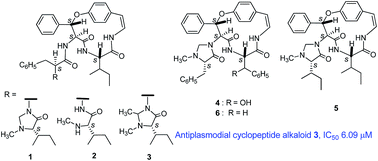New bioactive cyclopeptide alkaloids with rare terminal unit from the root bark of Ziziphus cambodiana†
Abstract
Six new 14-membered ring cyclopeptide alkaloids, cambodines A–F (1–6), and two known compounds, frangufoline (7) and lotusanine B (8), were isolated from the root bark extract of Ziziphus cambodiana Pierre. Their structures and configurations were established based on 1D and 2D NMR, HRMS, ECD, and X-ray crystallographic data. Compounds 1 and 3 are rare 5(14)-type cyclopeptide alkaloids that possess an imidazolidin-4-one ring in the terminal unit. The cyclopeptides were tested for their in vitro antiplasmodial, antitubercular, and cytotoxic effects against three cancer cell lines. Compound 3 showed significant antiplasmodial activity against the malarial parasite Plasmodium falciparum, with an IC50 value of 6.09 μM.



 Please wait while we load your content...
Please wait while we load your content...